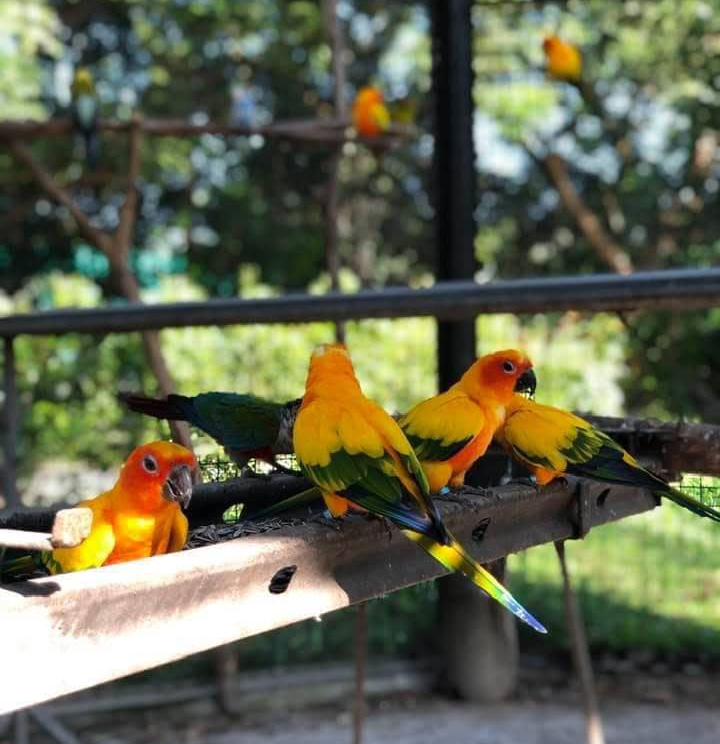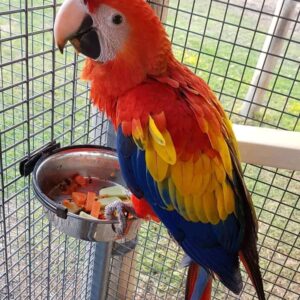Description
Buy Sun Conure (Parakeet) Online
The Sun Conure, also known as the Sun Parakeet, is considered to be one of the most beautiful birds in the Parrot family. The bird gained its popularity owing to its multifaceted personality that delights the experienced bird owner and piques the curiosity of the amateurs or non-bird person. The Sun Conure received its name from its bright yellow and green plumage. The sun conure has a black beak, white rings around its eyes, and a long, tapering tail. The sunny’s striking coloration and sweet temperament make it a favorite among pet owners and a darling with experienced aviculturists because it is easily bred. Immature birds do not reach their full coloration for about two years. Though the coloration between the sexes is very similar, the males are said to be slightly brighter. Males are also said to have a square, flatter head, and females a rounder, smaller head, though only experienced breeders are good at eyeing the birds and making an educated guess. Certainly, there’s no difference in pet quality. Coming in at around 12 inches in length and having a lifespan of up to 30 years, sun Conures are widely regarded as the most colorful of all the Conure species. This is because a mature Sun Conure sports plumage in a variety of shades of red, yellow, green, orange, blue, and some birds, tones of violet. The Sun Parakeet or Sun Conure for sale, (Aratinga solstitialis) is a medium-sized brightly coloured parrot native to northeastern South America. The adult male and female are similar in appearance, with predominantly golden-yellow plumage and orange-flushed underparts and faces. Sun conures /parakeets are very social birds, typically living in flocks. They form monogamous pairs for reproduction and nest in palm cavities in the tropics. Sun conures mainly feed on fruits, flowers, berries, blossoms, seeds, nuts, and insects. Conures are commonly bred and kept in aviculture and may live up to 30 years. This species is currently threatened by loss of habitat and trapping for plumage or the pet trade. On average, sun parakeets weigh around 110 g (4 oz) and are around 30 cm (12 in) long. The sexes are similar in plumage, although hens may be lighter and slenderer in body, having a shorter tail, with a smaller, rounder head and a smaller beak. Adults have a rich yellow crown, nape, mantle, lesser wing coverts, tips of the greater wing coverts, chest, and underwing coverts. The face and belly are orange with red around the ears. The base of the greater wing coverts, tertials, and base of the primaries are green, while the secondaries, tips of the primaries, and most of the primary coverts are dark blue. The tail is olive-green with a blue tip. From below, all the flight feathers are dark greyish. The bill is black. The legs and the bare eye-ring are grey, but the latter often fade to white in captivity (so using the amount of grey or white in the eye-ring for determining the "purity" of an individual can be misleading). It is easily confused with the closely related jandaya parakeet and sulfur-breasted parakeet, but the former has entirely green wing coverts, mantle, and vent, while the latter has green mottling to the mantle and less orange to the underparts. The sun parakeet is also superficially similar to the pale bill. Super Sun Conure is often also named by breeders as (Yellow-Factor Sun Conure) since there is also (Red-Factor Sun Conure). Juvenile sun parakeets display a predominantly green plumage and resemble similar-aged sulphur-breasted parakeets. The distinctive yellow, orange, and reddish coloration on the back, abdomen, and head is attained with maturity. Geography: NE South America Song / Call: Click here for Sun Conure Call
Size: About 10" tall
Sexing: Monomorphic (visually hard to determine sex). DNA testing is available to ensure the desired gender.
Life Span: 15 to 25 years
Temperament: Sun Conures are amusing, playful clowns who need plenty of entertainment and interaction. They are easily trained but will bite if provoked. In general, the sun conure is extremely affectionate and will be deeply loyal to a gentle owner. Like other members of the genus Aratinga, the sun parakeet is very social and typically occurs in large flocks of 15 to 30 individuals. They rarely leave the flock, but when they get separated from the group, they squawk and scream in a high-pitched voice which can carry for hundreds of yards, allowing individuals to communicate with their flock and return to them. Flocks are relatively quiet while feeding but are known to be very vocal and make loud noises when in flight. They can travel many miles in a single day, and they are fast, direct flyers. Nonverbal communication is also practised, with a variety of physical displays. Birds within a flock rest, feed one another, preen, and bathe throughout the daylight hours. They move through the trees using their beaks for extra support. They also have the ability to use their feet like hands to help hold, examine, or eat items. Sun conures have been reported to nest in palm cavities. When in molt, conures are uncomfortable, so are easily irritable. Bathing, warm rainfalls, and humidity allow the sheaths of each pin feather to open more easily and lessen their discomfort. Sun conures are extremely smart and curious, so require constant mental stimulation and social interaction. Their speech and ability to learn tricks in captivity are quite moderate. Otherwise, relatively little is known about their behaviour in the wild, in part due to confusion with the sulphur-breasted parakeet species. Regardless, the behavior of the two is unlikely to differ to any great extent.
Breeding: Encourage breeding of your sun conures by housing them together in a cage large enough to accommodate the two of them. Keep human interference and interaction to a minimum. Young sun conures form monogamous pairs around 4 to 5 months of age. Prior to breeding, they may be seen feeding and grooming one another. Mating can last up to three minutes, after which pairs become very affectionate with each other. Prior to egg laying, the female's abdomen noticeably swells. They have been known to nest in trees or in cavities of Maurita flexuosa palms. Fertility rate of sun conures is relatively high. Typical clutch size is three or four white eggs, and they may be laid in two- to three-day intervals. Pairs may only destroy and eat their eggs in cases of calcium deficiency. Females are responsible for the entire incubation period from 23 to 27 days, and only leave the nest for short feeding periods. Males aggressively protect the nest from potential predators. Eggs may fail to hatch if they are not kept warm or if the bird fails to break through the shell successfully, which may take from a few hours to a few days. Chicks are born blind, naked and completely vulnerable. Only after 10 days, they begin to open their eyes and their feather quills break through. Both parents participate in feeding the chicks. The young depend on their parents for 7 to 8 weeks after hatching, and only become independent after 9 to 12 weeks. Conures are sexually mature around 2 years of age and have a lifespan ranging from 25 to 30 years.
Diet: Lovebird/Conure Seed, Australian Blend Golden Feast, Dried Egg Food, Cuttlefish Bone, Fruit Pellets, Nuts, fresh fruit and veggies.
In the wild, sun conures mainly feed on fruits, flowers, berries, blossoms, seeds, nuts, and insects. They feed on both ripe and half-ripe seeds of both fruits and berries. They also consume red cactus fruit, Malpighia berries, and legume pods. At times, they forage from agricultural crops and may be considered pests. They require more protein intake during breeding season, more carbohydrates when rearing young, and more calcium during egg production.
In captivity, their diets may include grass seeds, beans, nuts, fruits (apples, papaya, bananas, oranges, grapefruits, strawberries, raspberries, blackberries, gooseberries, currants, rowans, elderberries, hawthorn berries, rose hips, cucumbers and tomatoes), vegetables (spinach, Chinese cabbage, cress, roquette, kale, broccoli, carrots, alfalfa, peas, endive, and sweet potatoes), dandelions, chickweed, soaked corn, germinated sunflower seeds and spray millet. They may also eat fruit tree buds (elderberry bushes, willows, hawthorn, and aspen), ant eggs, mealworms or their substitutes (hard-boiled eggs, bread, biscuits, hard cheese or low-fat cottage cheese). Cuttle bones, mineral blocks, and gravel or ground oyster shells may be given to aid in mechanical digestion.
https://youtu.be/yGQ158AseRg




j5suo –
very brilliant and vibrant conure. I recommend
Rosa Rivera –
Can I have costumer service and talk with them about this birds? I want to buy want and I have a long time emailing you and calling you